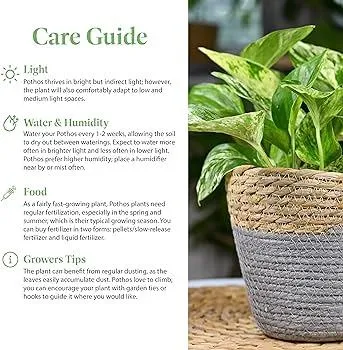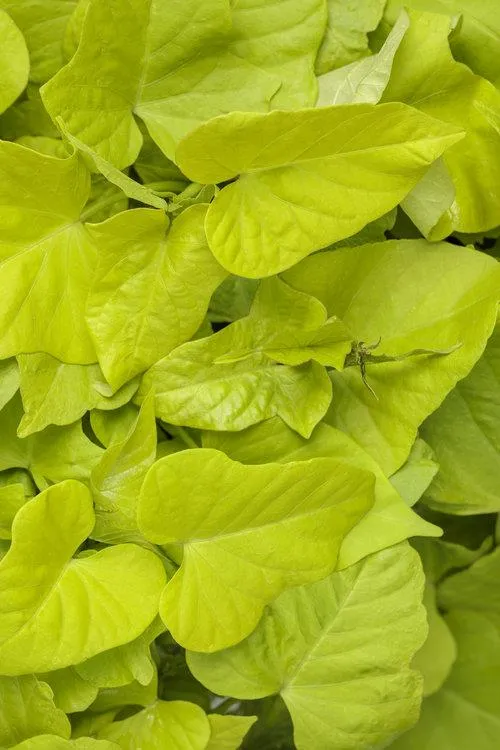A Comprehensive Guide to Caring for Your Ivy Plants
Whether you’re a new plant parent looking to spruce up your space with some greenery or a seasoned gardener wanting to learn more about these prolific climbers, this guide covers everything you need to know to keep your ivy thriving. From watering needs to pruning techniques to tackling potential pests, I’ll share my tips and tricks for caring for ivy gained from years of experience growing these beauties. Bear with me as I may wander off on a vine or two – it’s in their nature to ramble, after all. Let’s get climbing!
Choosing the Right Ivy Variety
With over 400 different types of ivy to choose from, deciding which variety is best for your space and care preferences can feel overwhelming. The good news? English ivy (Hedera helix) is one of the hardiest and lowest maintenance options. It thrives in a variety of light conditions from full sun to deep shade and tolerates both hot and cold climates well. English ivy is also very adaptable to different soil types and climbs beautifully up walls, trees, or trellises with its grippy tendrils. You really can’t go wrong choosing English ivy as your starter plant.
That said, if you want something with more colorful foliage, variegated ivy varieties like ‘Goldchild’ or ‘Margaret Stacey’ with cream and yellow streaks are absolutely stunning. And for a super flashy showstopper, look no further than Boston or Japanese ivies with their vibrant shades of crimson, burgundy, and chartreuse. Just be aware they require a bit more sun exposure and care than their hardier green counterpart. Kind of a tradeoff between low maintenance versus major plant pizzazz, if you ask me!
Planting and Potting Ivy
Whether you start with a rooted cutting, unpotted plant, or bare root ivy, the planting process is basically the same. Fill your container – be it a planter, hanging basket, or the ground – with well-draining potting soil. Remove any damaged or yellowed leaves from the ivy and check the roots for signs of disease before placing in the soil. Gently cover the roots, patting down the soil firmly. Then give your ivy a nice drink of water to settle it in. From there, you can train the stems to grow up a support or just let it spill over the sides of its container. The ivy will find its way, no worries.
As for pot size, err on the generous side. Ivy is a vigorous grower and will quickly outgrow a small container. Go with at least an 8-inch planter for a single plant and scale up from there depending on how full you want the ivy to grow. You can also cluster multiple ivy plants together in larger planters or hanging baskets for a lush, full effect. Just be sure not to overcrowd their roots.

Watering Ivy
When it comes to watering, ivy is quite thirsty! The number one cause of ivy death I’ve seen is under-watering, so don’t skimp on the H2O. As a general rule, water thoroughly whenever the top few inches of soil are dry. For container plants, this usually means watering every 5-7 days. But adjustments may be needed depending on your climate, light exposure, and pot drainage. Overcast or indoor areas will require more frequent watering than those basking in full sun all day.
To test if your ivy needs water, stick your finger an inch or two into the soil. If it feels dry, it’s time to drink! When you do water, soak the soil completely so the entire root ball is moistened. And never let ivy sit in soggy, soaked soil – aim to water thoroughly then allow the soil to dry out partially in between waterings. Following these tips should keep your ivy well hydrated without drowning its roots. Slaking that thirst is crucial for healthy, vigorous growth.
Fertilizing Ivy
While ivy is pretty hardy as a plant, some extra nutrients never hurt. Fertilize monthly in the spring and summer growing seasons with a balanced, water soluble houseplant formula. I like to use Miracle-Gro® BrightBlue® All Purpose Plant Food for its well-rounded blend of nitrogen, phosphorus, and potassium. Just follow the product instructions for the appropriate dilution. You can also fertilize weekly with liquid fish emulsion or compost tea for extra nutrition.
Whichever fertilizer you choose, apply it to dry soil and then water it in well after application. Be sure not to over-fertilize, as too much of a good thing can actually damage or burn delicate ivy roots. And during fall and winter when the plant is less actively growing, you can scale back fertilizing to every other month or as needed. Proper feeding will reward your ivy with lush foliage and encourage vigorous new growth.
Pruning and Training Ivy
- Pruning ivy is mainly for shaping and controlling its size. In early spring before new growth emerges, give your ivy a light trim to remove any spindly or diseased stems.
- As new growth comes in, you can carefully train vines up a support using twine or stakes. Gently twist emerging stems around the support every 4-6 inches as it climbs.
- For ivies growing as groundcovers or hanging plants, simply trim off longer vines or branches that start to spill over edges back to the main stems.
- To encourage a fuller, bushier shape, prune off individual flowering stems as buds start to form. This encourages more vegetative growth.
With regular light pruning, you can sculpt your ivy into an attractive wreath, heart shape, or spiral-like design over an archway. The possibilities are endless once you get the hang of training these vines. Just be sure not to cut back more than 1/3 at a time to avoid shocking the plant. With a little creativity, ivy can be an artistic addition rather than just a simple groundcover.

Dealing with Ivy Pests
Mealybugs are unfortunately like, the number one enemy of most houseplants – including ivy. The cottony white bugs suck sap from new growth, leavingtelltale signs of yellowing or drooping leaves. Look out for fluffy masses along stems and between leaf joints as early detection is key. Wipe roots and rinse thoroughly before repotting to avoid spread. A q-tip dipped in rubbing alcohol works wonders for quick spot treatment of visible bugs too.
Spider mites also plague ivy in dry indoor environments. Your plant may appear dusty or develop stippling if infested. Try misting regularly to raise humidity levels above 50% and deter mites. As a last resort, neem oil spray or insecticidal soap can offer more heavy-duty control. But prevention is always easier than pest cures, so watch moisture levels and isolate new plants till settled.
Luckily, ivy is pretty pest-resistant as long as cared for properly. Give your plant the TLC it deserves – like you would any friend – and hopefully pests won’t be a major issue. But nature has her surprises, so just stay vigilant and nimble should any creeps try crawling onto your vines. With early treatment, they’re easy enough to scrape off!
So in summary, English ivy is a versatile plant that thrives with regular water, fertilizer, and occasional pruning or trimming back. Proper care will reward you with lush foliage for years, whether trained up a wall, flowing in a hanging basket, or spilling as a dense groundcover. I hope these tips have given you the confidence to start your own climbing adventure! Feel free to DM me if you have any other ivy questions – I’m always happy to chat plants.
Tips for Caring for Your Ivy Plant
| Light | Water | Soil | Pruning | Temperature |
|---|---|---|---|---|
| Partial shade to full sun | Keep soil moist but not soaked. Water when top inch of soil is dry. | Rich, well-draining potting soil or loam-based potting mix | Pinch off growing tips to encourage bushiness. Prune as desired after flowering. | 50-70°F for best growth. Tolerates light frost. |
| At least 4 hours of direct sunlight per day | Do not overwater. Excess water causes leaves to drop. | Add compost or other organic matter to improve drainage and nutrient retention. | Remove any damaged or diseased parts. Cut back in late winter or early spring. | Protect from winds and direct sun if temperatures rise above 80°F. |
| East, west or north-facing window is ideal | Let soil dry out slightly between waterings. | Well-draining, porous potting mix specifically for vines or climbing plants. | Prune as needed to control size, shape or to remove older stems. | Tolerates temperatures down to 25°F if protected from wind. |
FAQ
-
How often should I water ivy?
Ivy likes to stay moist but not soggy. Water about once a week in the summer unless it’s very hot out – then you may need to water more. In the winter, cut watering back to once every couple of weeks or so since ivy doesn’t need as much moisture when it’s not growing as fast. The soil should dry out a little between waterings.

-
How much sunlight does ivy need?
Ivy can tolerate a wide range of light conditions. It will grow in full sun but does best with partial shade. Direct afternoon sun can dry out the leaves, so dappled light or morning sun is best. However, it will also grow well in low-light areas like north-facing windows. So you’ve got some flexibility on where to put it depending on what kind of light you’ve got.
-
What type of soil does ivy prefer?
Ivy is pretty adaptable when it comes to soil. It will grow in most well-drained potting mixes. A decent potting soil with some compost mixed in should do the trick. The soil shouldn’t stay soggy after watering. You can add perlite or vermiculite to improve drainage if needed. Ivy doesn’t demand nutrient-rich soil, but it will benefit from an occasional application of balanced houseplant fertilizer in the spring and summer.
-
How do I prune ivy?
You can trim back ivy any time to maintain its shape and size or contain its growth. Cut stems back by about a third. In spring, you can give the plant a heavier prune to encourage bushier new growth. Use sharp pruners or shears and cut right above a leaf node. Ivy will send out new shoots from those nodes. You may want to prune less in winter so the plant doesn’t lose too much of its structure when not actively growing.
-
Can ivy be invasive in the garden?
Some ivy varieties can become invasive outdoors since they spread quickly with aerial roots that descend and take root. English ivy is one known to spread aggressively. However, other cultivars grow more slowly and may stay contained better if planted in an appropriate spot. Confine fast-growing types with planters above ground or below in the soil. Monitor them regularly for signs they may be escaping their boundaries. Be sure to pick a suitable variety for your space to avoid wrangling runaway vines.
-
What problems might ivy have?
The main issues for ivy could be scale insects, spider mites or mealybugs sucking sap from the leaves. Look for grayish spots or webbing. Isolate the plant and wipe pests off with alcohol on a cotton ball. Regularly check for signs and treat with neem oil or insecticidal soap if an infestation appears. Ivy may also develop brown spots or leaf drop from too much or too little water or light. Check care conditions and adjust as needed. Overall it’s usually not too demanding to keep looking good.

